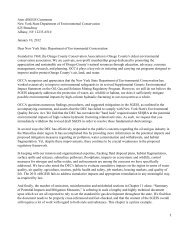Oil and Gas at Your Door? (2005 Edition) - Earthworks
Oil and Gas at Your Door? (2005 Edition) - Earthworks
Oil and Gas at Your Door? (2005 Edition) - Earthworks
Create successful ePaper yourself
Turn your PDF publications into a flip-book with our unique Google optimized e-Paper software.
IMPACTS ASSOCIATED WITH OIL AND GAS<br />
AIR EMISSIONS<br />
As seen in the table below, there are several types of air emissions in the drilling <strong>and</strong> production<br />
process. The following table provides inform<strong>at</strong>ion on air quality concerns rel<strong>at</strong>ed to oil <strong>and</strong><br />
gas in different parts of the country.<br />
Some of the key sources of air emissions include the following:<br />
245<br />
1. Fugitive emissions from leaking tubing, valves, tanks, <strong>and</strong> open pits, or intentional venting<br />
of n<strong>at</strong>ural gas may release vol<strong>at</strong>ile organic compounds (VOCs) 246 <strong>and</strong> hydrogen sulfide.<br />
• VOCs are carbon-containing substances th<strong>at</strong> readily evapor<strong>at</strong>e into the air. They can<br />
combine with nitrogen oxides to form ground-level ozone, which can cause respir<strong>at</strong>ory<br />
ailments such as asthma, <strong>and</strong> decreased lung function (see following page for more<br />
inform<strong>at</strong>ion). Examples are benzene <strong>and</strong> toluene.<br />
2. Particul<strong>at</strong>e M<strong>at</strong>ter is essentially small particles th<strong>at</strong> are suspended in the air <strong>and</strong> settle to<br />
the ground slowly. These particles may be re-suspended if disturbed. The most common<br />
sources of particul<strong>at</strong>e m<strong>at</strong>ter from oil <strong>and</strong> gas oper<strong>at</strong>ions are dust or soil entering the air<br />
during pad construction or from traffic on access roads; <strong>and</strong> diesel exhaust from vehicles<br />
or engines used <strong>at</strong> oil <strong>and</strong> gas facilities.<br />
• PM 10 particles (with diameters less than 10 micrometers or µm) are small enough to<br />
be inhaled <strong>and</strong> can cause adverse health effects.<br />
• PM 2.5 particles (with diameters less than 2.5 µm) can lodge deep within the lungs<br />
<strong>and</strong> cause serious health problems. PM 2.5 particles are the main cause of visibility<br />
impairment (haze). Secondary particles are formed through chemical reactions involving<br />
gases <strong>and</strong> other particles in the <strong>at</strong>mosphere. Particles formed in this manner are<br />
fine particles (< 2.5 µm). The most common precursor gases involved in these reactions<br />
are nitrogen oxides (NOx), sulphur dioxide (SO 2 ), vol<strong>at</strong>ile organic compounds<br />
(VOCs) <strong>and</strong> ammonia (NH 3 ). 247 SO 2 , NO x <strong>and</strong> VOCs are all emitted during oil <strong>and</strong> gas<br />
oper<strong>at</strong>ions.<br />
• For residents living along unpaved roads or near well pads, dust can penetr<strong>at</strong>e their<br />
homes causing a nuisance <strong>and</strong> health problems such as hay fever <strong>and</strong> allergies. Crops<br />
Studies over the last<br />
15 years show th<strong>at</strong><br />
low levels of ozone,<br />
most certainly <strong>at</strong> 50<br />
to 60 parts per billion<br />
(34-24 ppb below the<br />
federal limit) are<br />
detrimental to health.<br />
American Journal of<br />
Respir<strong>at</strong>ory <strong>and</strong> Critical<br />
Care Medicine<br />
I-51




